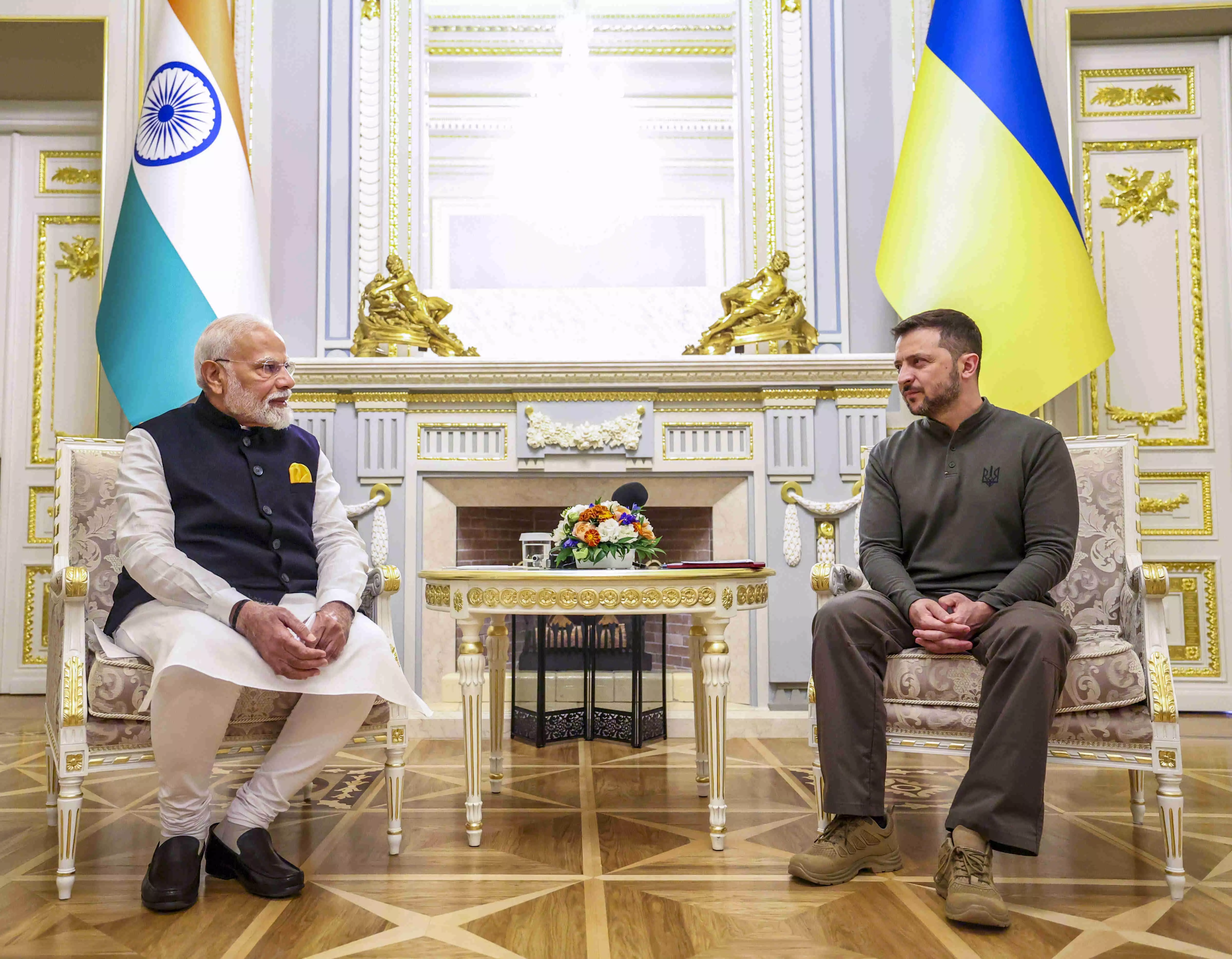A meeting for peace

Prime Minister Narendra Modi’s visit to war-torn Ukraine was greeted by the cheering Indian diaspora, including medical students, but also encountered shades of dismay as the PM, along with Ukrainian President Volodymyr Zelensky, paid tribute to the memory of deceased children at Martyrologist Exposition. In a country that has been battered by the ravages of war for two-and-a-half years, the Mariinsky Palace was adorned for official business for the Indian PM. In this palpable sense of irony lay the hope that the Indian PM would play his part in ending the hostilities between his ally Russia and Ukraine.
Interestingly, Modi's Ukraine visit—first by an Indian PM in independent Ukraine’s history—followed his controversial July meeting with Russian President Vladimir Putin in Moscow. The Modi-Putin meeting drew sharp criticism from Western capitals. Ukrainian President Volodymyr Zelensky was particularly vocal in expressing discontent, saying he was “disappointed to see the leader of the world's largest democracy hug the world's most bloody criminal in Moscow”. As much as his statement was about discontent, it also spoke volumes about the hopes he has from India. Modi, on his part, asserted with “great conviction” that India has not been “indifferent” to the war in Ukraine. Rather, it has taken a side—standing “firmly for peace”. Modi’s Ukraine visit has been labelled—in an unsubstantiated manner—by Western nations and media as an attempt to placate Zelensky and the West in the aftermath of Modi-Putin meeting. However, none can deny the pivotal potential India has assumed as an emerging global leader that is amicable to both the parties in conflict. On the eve of his visit, Modi reiterated India’s stand of promoting “dialogue and diplomacy” for ensuring “peace and stability”—asserting that “no problem can be solved on the battlefield.” If observed closely, this stand is an antithesis of Western belief and actions that are hell-bent on fuelling the war against Russia by using Ukraine as a pawn. There is no paucity of examples when the Western world, particularly the US, triggered regional conflicts across the globe—intentionally or otherwise—plunging nations into a state of instability and chaos for decades. At one point in time, India itself had been a victim of the same. While the valour and national sentiment of Ukrainians in fighting the war is of highest order, there is no guarantee these adorable traits are channelled in the right direction. Against this background, rooting for “practical engagement”, Modi said in very certain terms: “Ukraine and Russia need to engage with each other to find a solution to the ongoing conflict between them.” But then again, the moot question remains, can India’s suggested path of “dialogue and diplomacy” lead the warring nations to a mutually acceptable position? If that happens, it would be one of the greatest achievements of this century.
Even if that appears to be a far off possibility as of now, there is a lot of substance in Modi’s Ukraine visit. India has always been known for its ability to navigate complex international dynamics without aligning itself too closely with any single power bloc. This diplomatic balancing act has been a cornerstone of India's foreign policy for decades, allowing the country to maintain strong relations with nations that may be at odds with one another. Modi and Zelensky are reported to have signed four agreements—India’s humanitarian assistance for high-capacity development projects, agriculture, cultural cooperation and medicines and drugs. The Indian PM also handed over the much-talked-about BHISHM Cube—a mobile hospital designed for disaster management—to Ukraine. The visit is also being speculated as a part of a broader strategy to deepen India’s engagement with Europe, particularly Central and Eastern Europe. By visiting Poland and Ukraine, Modi is acknowledging the growing geopolitical significance of these regions and the need for India to build stronger ties with them. Beyond defence or diplomacy, it may be about positioning India as a key player in a rapidly changing global order.
In a nutshell, Modi’s visit has reinforced India’s strategic autonomy, highlighted its commitment to peaceful conflict resolution, and showcased the country’s broader ambitions on the global stage. While the visit may not have resulted in immediate solution to the ongoing conflict, it is a crucial step in India’s continued effort to seek peace, maintain balance, and pursue its national interests in a highly polarised world.



